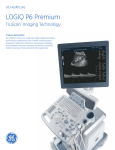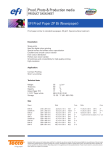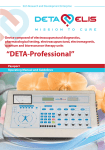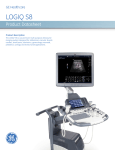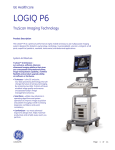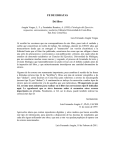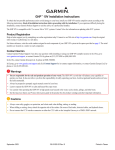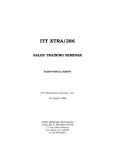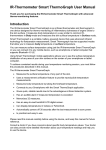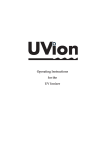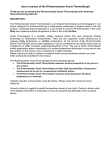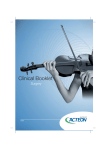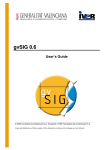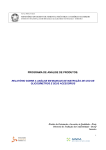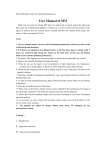Download to this video in PDF
Transcript
Bioresonance and EAV Instruments Holimed Private Institute for Holistic Medicine Systems GmbH Bioresonance and EAV Cutting-Edge Technology Contents at a Glance This brochure is designed to introduce you to our range of instruments for bioresonance and electroacupuncture according to Dr Voll (EAV) You will find the following information: Bioresonance The basic principles of bioresonance and our systems RemiWave Pro, the universal bioresonance system 3 4 bioswing Pro 10 bioswing Praxis 11 Electroacupuncture According to Dr Voll (EAV) The basic principles of Electroacupuncture according to Dr Voll (EAV) biocheck Pro 12 14 biocheck Mini and Maxi 16 Bioresonance and EAV accessories 17 Training courses 18 2 Bioresonance and EAV Cutting-Edge Technology Easy to Use Portable Fast Return on Your Investment At a Reasonable Cost Time-proven standard since 1994 - dedication to continuous improvement success throughout the world Bioresonance Bioresonance is based on the assumption that we can also view the human body as a system of oscillations and fields that reflect its vital state and aid in the coordination of energetic regulation processes. The approach focuses on the oscillations of the body‘s molecular and atomic building blocks where bioinformation is thought to be stored. This is considered to be in the water found in the connective tissues (the matrix). According to Professor Popp, Marco Bischof, and others, this information interacts with the coordinating system of the biophotons from the nuclei. Whereas there are also several other theories and hypotheses on the basic principles of bioresonance, it was Dr Morell who made a decisive discovery almost by chance in the 1970s: He found that these oscillations can be captured via an electromagnetic phenomenon in the human body. These oscillations can be processed electronically (e.g., filtered and attenuated or amplified) and then fed back to the body in order to normalize the electrical conductibility of acupuncture nodes. Although this technology has been applied since the end of the 1970s, bioresonance instruments have previously been very expensive, making them difficult to finance and use profitably - especially for people at the start of their professional careers. We at Holimed set ourselves the task of offering technologically cutting-edge systems and instruments at fair prices that will enable you to recover your investment in a reasonable time. We are also very much aware that your task is to care for your clients and not be distracted by instruments. This is why we place great value on ensuring that all our systems are practical, simple, and convenient to operate. Our systems set the international standard and are also marketed under other brand names such as WaveMaker™ and Wavemaker Pro™ by Great Life Technologies, USA. 3 What‘s so special about RemiWave Pro and bioswing Pro? Most instruments belonging to earlier generations, many of which are still on sale today, can only process a wave range of approximately 10 to 180,000 Hz*- and sometimes only up to 100,000 Hz. Moreover, several of them do not even possess bandpass technology, simply demanding high prices for only simple high- or low-pass filters from the early days of bioresonance technology. Because our research confirmed that the effective range of these older instruments was far too narrow, our first model, the bioswingPraxis from 1994, was already equipped with highly selective hi-tech bandpasses covering a range from about 3 Hz to 400,000 Hz. More recent experiments by J. Lipkpova and J. Cechak in 2005 have confirmed our findings and emphasize the importance of both the lower and the higher oscillation range. In the year 2000, we refined our technology even further. After carrying out a comprehensive series of tests, we extended the oscillation range from 0 Hz (direct current electricity) to up to 500.000 Hz. We included direct current, because Robert O. Becker and others have ascertained how disturbances may lead to changes in this weak static field among mammals. More recent tests have shown that the inclusion of additional frequency clusters ranging from approximately 500-650 kHz and from 800-1,000 kHz (1 megaherz) markedly accelerates the normalization of EAV scores. Therefore, today‘s RemiWave Pro covers a range from 0 Hz to 1,000,000 Hz. The bandpasses** built into the Holimed systems possess one very special feature compared to other products. They work with a constantly narrow bandwidth across the entire oscillation spectrum processed, making them highly selective. If you compare the correlations between homeopathic dilutions with the oscillation frequencies found by Dr Morell, the advantage is plain to see: precise transfers even up to high wavebands or their equivalents in potencies. A further unique and as yet unparalleled feature of Holimed systems is our special automatic mode. It makes our instruments particularly easy to use, making awkward and time-consuming adjustments a thing of the past. Applying precisely tested parameters, this mode scans both the oscillation spectrum and the corresponding amplification. Multidimensional scanning of the client‘s energetic resonance then leads to a particularly rapid normalization of EAV readings. With these basic explanations in mind, let us now take a quick look at the RemiWave Pro and bioswing systems. *Hz is the scientific abbreviation for hertz = cycles per second. **A bandpass is a filter that ideally blocks just about everything except the one more or less narrow range of oscillations that one wants. It can be compared to a colored glass lens that allows only light of this one color to pass through it. 4 RemiWave Pro RemiWave Pro is our flagship for all possible applications of bioresonance. All features at a glance 9 8 1 3 6 7 4 2 5 Fast and easy to operate - learned in a matter of minutes. 1. Direct selection of the transfer source: the client‘s waves, the built-in test tray, or both. Using both will shorten the application time, for example, when energetically transferring allergens. 2. Simple choice of operating mode: Automatic, Constant (without PC), or Online (with PC). 3. Simple switching between inverse (Ai) “neutralizing“ or noninverse (A) “reinforcing“ applications. Just press the start button to commence transfer. 4. Two separate and decoupled input channels for the additional connection of electrodes. Decoupling prevents the short-circuiting of meridians and allows a focused processing of individual waves. 5. Two separate - and again decoupled - output channels. The second channel has numerous uses, for example, in meridian-flooding or simultaneously transferring information to an additional test tray. 6.&7. “Hold“ and “Skip“ allowing the client to intervene directly in the transfer process. 8. RemiWave Pro is powered by rechargeable batteries and completely independent from the electricity grid. This grants maximum client safety and prevents all possible interference due to mains electricity that even the best of filters are unable to block. 9. You can operate RemiWave Pro remotely by PC/Laptop via a digital, nonelectrical glass fiber connection. The client is always disconnected from the output while parameters are being transferred. Any potential interference from the PC is impossible because the light is off when no data are being sent. This guarantees maximum screening insulation from mains electricity, thereby ensuring safety and preventing any possible interference due to the PC. 5 RemiWave Pro covers an oscillation range from direct current (0 Hz) to 1,000,000 Hz (1 MHz). This corresponds to a spectrum of auditory oscillations up to medium radio wave - almost six times that of other instruments. The integrated automatic calibration unit ensures that your instrument will remain precisely adjusted even after many years of use and exposure to different climatic conditions. With Holimed technology, you can be certain that the information in your test samples will be transferred without any of the temporal distortions pertaining to simple high-/low-pass driven instruments. One of the advantages of this precise transfer is that test samples transferred to water for the EAV test (or any other test method) retain their information for a very long time even more than 10 years, as our own test sample comparisons have shown. RemiWave Pro can be used in stand-alone mode or with a PC. In stand-alone, use the extended automatic mode to ensure the best possible normalization. No further adjustments are necessary apart from selecting the type of transfer (inverse [Ai] or noninverse [A]) and what should be transferred (over the input channels or the built-in test tray). The instrument will do everything else by itself. With the constant modes, you can energetically test, for example, allergens in the base substance or carry out Martin Keymer‘s crosslinked testing technique. With a PC, you can operate your RemiWave Pro completely externally and very flexibly. Socalled programs provide you with set parameters for many frequently observed conditions, and you can apply these straight away with just a few mouse clicks. In the following, we shall take a closer look at this wide range of easy-to-use PC functions. Maximum flexibility at the click of a mouse via your PC You are looking for a suitable program for your client? Searching through endless lists and big heavy books is a thing of the past. Use the comfortable search function in our PC program. Just type in the first letters of the term you are looking for, and you will immediately see a list of possible alternatives. A single click on the chosen option will load the program, and you can start straight away. 6 Elementary Building Blocks Are the Single Programs Bioresonance programs consist of sets of parameters, the elementary single programs. In some ways, these are comparable to a test sample. The table of single programs below does not just give you the title and additional information but also the basic parameters for the transfer. A single mouse click will start the program. Many of the programs you will be wanting to choose are such single programs. These include the meridian programs and a number of energetic organ programs. Additionally, you can use tables that list your favorite programs, making your work even easier and quicker. To load the program, just click on the title. In the favorites tables, you will find a list of frequently used programs specially compiled for your convenience. Naturally, you can change or add programs to this list in line with your personal needs. Already prepared for your individual customization You can extend the functional range of your programs in a flexible way and adapt them to your personal requirements. For example, do you want to try out Rife, Clark, Solfeggio, or some other similar frequencies? All you have to do is enter the data from your frequency tables (to be found, e.g., in the Internet) in the corresponding fields, give the program a title so that you will be able to find it again, and save it with a click. Your program is now available in the search function, and can be started straight away. 7 Multiprograms for more complex applications It‘s a familiar phenomenon in an EAV resonance test: You often find that you need several test samples to normalize different acupuncture nodes. The reason for multiprograms is very similar. These are programs made up of several single steps carried out in succession. However, you don‘t have to make any complicated entries. Once you have found an appropriate multiprogram using the search function, all you need is one mouse click and the program is loaded and ready to start. You only have to press Start! Tease a drowsy regulation system awake with a mouse click Many energetic stresses can only be normalized slowly; either because the regulation system has become sluggish or even because it seems to be partly blocked. This is a familiar problem in other domains such as neural networks. And you also come across the same phenomenon here: In such systems, you regularly find that while trying to normalize the system, you get stuck in a “trough“ that is far from your actual goal. The reasons for this are physical. If you don‘t introduce further measures, the system may well get stuck there for ever and simply remain blocked. The way to reactivate the system is to give it a “kick.“ This kick will overcome the blockade, so that you can go on to adjust the system optimally. What you have to do is to switch between an impulse (a kick) and its normalization. This is exactly what the impulse program does (also known as the energetic “parasite program“). The automatic switching between noninverse (A) and inverse (Ai) with coordinated parameters is the key to quickly attaining normalization even in difficult cases. The mode “noninverse“ is also known as “in-phase“ to point out that the information is presented without being shifted, that is, in its original structure. 8 You haven‘t got a suitable test sample or program? No problem with RemiWave Pro! You are faced with a case in which you cannot find a test sample or a program that fits. This would be a real problem without your RemiWave Pro. With RemiWave Pro, you simply apply the integrated parameter scanner function, and just a few simple steps will produce the right parameters to energetically normalize your client. Start the scanner, and simply enter whether or not, for example, the EAV readings or kinesiological muscle test reactions have improved. The software will then guide your RemiWave Pro automatically and lead you to the appropriate wave frequency and the other parameters. If you want to keep these settings, simply save the resulting program for the next session. Instead of EAV, you can use any other energetic test procedure such as RAC, muscle test, or tensor rod. Since 2002, we have been constantly improving our PC software for RemiWave Pro and introducing new functions. It is designed to run on a standard PC using Microsoft Windows XP™, Vista™, or Windows 7™. The following pages will now introduce you to our smaller standard systems bioswing Pro and bioswingPraxis. 9 bioswing Pro If you prefer to work without a PC, bioswing Pro is the ideal alternative. Simply press the Start button to commence transfer. The operating signal tells you which mode you are in: red = noninverse (A); green = inverse (Ai). Use the rotary switch to set the phase mode: inverse (Ai) or noninverse (A). Use the operating mode switch to set the application time in automatic mode or to choose a set amplification for either the resonance test or Martin Keymer‘s crosslinked testing technique. You can either connect the input cable to the test tray containing the samples that your tests have shown to be normalizing or you can connect it to the client. The first alternative is called exogenous and the second endogenous bioresonance. You can plug in the output cable to either transfer waves to a second test tray or place the output electrode in your client‘s hand. This handy instrument offers all the important basic functions for bioresonance at a very fair price. You can start working straight away without having to attend any courses. The unique automatic mode, specially developed by Holimed, removes the need to make complicated adjustments. All you have to do is select the type of transfer, either inverse (Ai) or noninverse (A), set the time in automatic mode, and press the Start button. The instrument itself will look after all the rest. The detailed user manual will tell you how to connect the electrodes and use the instrument in a series of four-color illustrations. The manual also contains many tips to help you with your work. The transfer range for oscillations extends from direct current (0 Hz) to approximately 550,000 Hz. Amplification ranges from one tenth to one hundred. Like RemiWave Pro, bioswing Pro is completely independent from the electricity grid and is powered by standard rechargeable batteries that you can either purchase from us directly or find at many electronics retailers. There is no need to return it to the manufacturer for expensive and time-consuming battery changes. 10 Electroacupuncture According to Dr Voll (EAV) EAV goes back to research carried out by Dr Voll. He found that the electrical resistance over acupuncture nodes follows a significantly different trajectory compared to normal skin surfaces. This difference is known as the plateau effect. In contrast to the rest of the skin, measurements over a certain area are not influenced by changes in pressure. The Plateau Effect Scale Skin Plateau Node Change in Pressure Pressure Readings are recorded on a scale from 0-100 with the so-called normal score being set at 50. This scale is based on a transformation of the actual reading. This transformation forms the basis for all EAV analyses, and EAV instruments have to be calibrated precisely according to this function. The calibration is easy to verify. EAV assigns the reading at an acupuncture node to categories such as “overactive,“ “subdued,“ or “exhausted.“ You can find out more about this in the literature. Energetic imbalances accordingly lead to high or low readings or to a drop in readings known as an indicator drop. The amazing phenomenon was the discovery that the electrical resistance at acupuncture nodes (e.g., the terminal nodes of the meridians on the hands and the feet) changes rapidly when the client comes into direct or indirect contact with some “matching“ external substances. Even without any direct contact between the client and a “suitable“ test sample (i.e., a sample inside a sealed glass phial), the acupuncture node reading will change immediately if an interaction occurs. All that is necessary is to place the test sample in a test tray linked to the client over a cable. The reasons for this phenomenon have yet to be explained. According to Dr. Voll‘s work, this leads any user of EAV to the following conclusion: If a test sample normalizes an imbalanced acupuncture node to a reading of 50, then this indicates not only the presence of an energetic imbalance but also that this test sample can rectify it. This procedure is called the EAV resonance test. biocheck Pro is the instrument you need for reliably measuring EAV nodes and carrying out the resonance test. The easiest way to perform acupuncture measurement is at the so-called “terminal nodes“ on the hands and the feet. They are easy to localize and simple to measure. 12 Many of the classifications of meridians to individual organs or groups of organs come from Traditional Chinese Medicine (TCM). Others are based on empirical tests by Dr Voll and his followers. According to TCM, this classification of meridians to organs has yet to be confirmed scientifically and in medicine. Hence, it can only be interpreted hypothetically in an energetic sense. Amazingly, however, the substances frequently correspond to the structures related to the meridians. How Do I Carry Out a Resonance Test? You can perform a resonance test with a test tray linked directly to the client through the reference electrode attached to the instrument. Initially, you measure all the nodes in question in order to determine the status quo. Next, you choose the meridian whose reading deviates most strongly from the normal value of 50, and place test samples that are assumed to be normalizing in the test tray. Then, you measure the particular acupuncture node again and note any change on the scale. By using appropriate test kits, you can effectively limit the group of substances that will have a normalizing effect on the readings at the acupuncture nodes. As a result, a resonance test takes only a few minutes.. You can find out all about the range of possible applications for EAV by reading the extensive specialist literature or attending one of the many seminars. The EAV measurement nodes on the Hand Allergy Organ metabolism Endocrine system Heart Small intestine 13 The EAV measurement nodes on the Foot Stomach Special checks (TCM Pericard) Connective tissue Joints Skin Nerves / Spinal Column Liver Large intestine Gall bladder Spleen / Pancreas Lungs L ymphatic system Fatty organ issues Kidneys Bladder biocheck Pro The convenient way to work with EAV The operating signal tells you what measurement mode you are in DrVoll‘s calibrated measurement scale on a large, easy-to-read instrument Sensors for remote PC operation Sensor switch - 2.5uA low current mode - 10 uA standard mode Sensor switch for search mode Sensor: Display last maximum reading Stylus input with screw connection Socket for reference electrode All our EAV systems in the biocheck range are calibrated precisely according to Dr Voll‘s transformation function. Thanks to digital signal processing, this calibration will remain accurate for many years. Even instruments returned to us for servicing after 15 years are still completely accurate. The new biocheck Pro operating concept saves you from having to lay aside the stylus every time you want to operate the instrument. When you need to change mode, you simply touch one of the sensors with the tip of the stylus and carry on measuring straight away. The sensors can also be used to operate the PC software. This means you can concentrate on your client and let the PC do what it is supposed to do: be your assistant One particular feature of biocheck measurement instruments since 1994 is the low measurement current. Back in the 1970s, Dr Kramer warned that the standard measuring current ranging from 5 microamperes for low up to more than 16 microamperes for high measurements (with a mean of 10 microamperes) is too high for many clients. If you do not manage to find the right test sample in the resonance test straight away, the nodes may rapidly become traumatized. In addition, the old procedure applied varying electrical charges to the measurement nodes, thereby introducing further uncertainties into the readings. Our industrial know-how has enabled us to modify the measurement principle so that the maximum measuring current is about 2.5 microamperes, and this remains almost completely constant over the entire domain. As a result, there is no longer any risk of traumatizing the measurement nodes through electricity - even when you have to perform repeated follow-up measurements of the same node. Nonetheless, at the flip of a switch, you can also return your biocheck Pro to the old pre-1994 mode - for example, if you are in the process of familiarizing yourself with the new instrument and want to have the same “feeling“ regarding the indicator movement as that in your old instrument. 14 One small, but very useful feature of biocheck Pro is the maximum reading sensor. Values often drop so quickly that you have hardly any chance to note the maximum, and this is very important when carrying out the resonance test. This feature is then “worth its weight in gold.“ All you have to do is touch the maximum reading senor with the tip of your stylus and the last maximum reading will appear straight away. The integrated node search assistant will help you handle surface nodes that are hard to detect. An auditory signal will guide you to the node, and once you are there, the instrument will switch automatically into measuring mode. Easy to Measure With the PC Usually, you simply write down the EAV readings or plot them on a chart as points or arrows. However, this is tedious, disrupts measurement, and distracts you from your client. biocheck Pro PC software will do this work for you - your PC becomes your assistant. The software monitors the reading, automatically traces the rises, drops, and turning points, and emits a signal telling you when you can move on to the next node. The software enters the reading at each meridian onto an easy-to-read chart. By tipping on the remote PC sensors on the instrument, you can switch to the next meridian and carry on measuring. This enables you to complete all your measurements in just a few minutes. You can concentrate on your client and let the PC get on with its work. The chart delivers both the basic measurement readings (e.g., the arrows in the illustration above) and the resonance test scores (the green dots at the 50 line in the illustration). You can make a direct before-and-after comparison. Using the zoom function for the single tables, you can show the findings to your client and discuss them. For your case files, you can either print out the tables, use an additional program to save them in your PC as pdf files, or - as the latest new feature - store them in the local biocheck Pro database. 15 Accessories for a variety of possible applications A perfect complement to EAV and bioresonance A test tray with a specially neutralized contaminant-free corundum surface for EAV, kinesiological tests, or information transfer. A magnetic hand electrode with very strong embedded rare-earth magnets. Otherwise known as a depth probe. You will have to test out the correct positioning (North or South pole facing upward). Normally, only one direction has the strongest normalization effect. A roller electrode for flexible local applications. A spot electrode for local applications, for example, on a single acupuncture node or for flooding meridians. A pair of gold-plated foot electrodes for irritated foot nodes. Experience has shown that bioresonance will have a faster normalization effect when information is applied close to the disturbance. A surface electrode in gold-plated brass for use on large body surfaces with VelcroTM fastener and extension band. Through many years of experience with EAV applications, we have assembled a great variety of EAV test kits. These are not just a random collection of samples, but those that experience has shown to be the ones needing to be tested most frequently. The test kits are carefully sorted into natural-wood drawers and arranged according to the acupuncture nodes. The accompanying topography helps you find your way quickly, so that you can start using the test sample sets straight away. Empty drawer units can also be ordered separately. Please note that test kits may not be available in some countries. 17
















